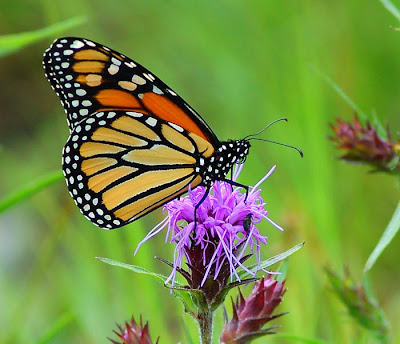Beauty Of Animal | Butterfly-Monarch | The Monarch butterfly (Danaus plexippus) is a milkweed butterfly (subfamily Danainae), in the family Nymphalidae. It is perhaps the best known of all North American butterflies. Since the 19th century, it has been found in New Zealand, and in Australia since 1871 where it is called the Wanderer. In Europe it is resident in the Canary Islands, the Azores, and Madeira, and is found as an occasional migrant in Western Europe. Its wings feature an easily recognizable orange and black pattern, with a wingspan of 8.9–10.2 centimetres (3½–4 in). (The Viceroy butterfly has a similar size, color, and pattern, but can be distinguished by an extra black stripe across the hind wing.) Female Monarchs have darker veins on their wings, and the males have a spot called the "androconium" in the center of each hind wing from which pheromones are released. Males are also slightly larger.The Monarch is famous for its southward migration and northward return in summer from Canada to Mexico and Baja California which spans the life of three to four generations of the butterfly.
The common name “Monarch” was first published in 1874 by Samuel H. Scudder because “it is one of the largest of our butterflies, and rules a vast domain”.But the name may be in honour of King William III of England. The Monarch was one of the many species originally described by Linnaeus in his Systema Naturae of 1758. It was first placed in the genus Papilio. In 1780, Jan Krzysztof Kluk used the Monarch as the type species for a new genus; Danaus. Since Latin grammar requires that the specific epithet and gender names agree it is unclear if the genus Danaus is drawn from Danaus , a mythical king of Egypt and great-grandson of Zeus or is a masculinised version of Danaë ,Danaus’s great-great-granddaughter. The species name, plexippus, refers to Plexippus, one of the 50 sons of Aegyptus, Danaus’ twin brother. In Homeric Greek δαναος πληξιππος also means "a Greek who beats (= lashes, drives and urges on) horses", i.e. "Greek charioteer".The Monarch is closely related to two very similar species which formed the Danaus (Danaus) subgenus before 2005. The first is the Jamaican monarch (D. cleophile) from Jamaica and Hispaniola. The second is the Southern Monarch (D. erippus), of South America south of the Amazon river.
The Southern Monarch is almost indistinguishable from the Monarch as an adult, the pupae are somewhat different, and is often considered a subspecies of the Monarch proper. But analysis of morphological, mtDNA 12S rRNA, cytochrome c oxidase subunit I, nuclear DNA 18S rRNA and EF1 subunit α sequence data by Smith et al. (2005) indicates that it is better considered a distinct species. The separation of the Monarch and Southern Monarch is comparatively recent. In all likelihood, the ancestors of the Southern Monarch separated from the Monarch's population some 2 mya, at the end of the Pliocene. At the time sea levels were higher and the entire Amazonas lowland was a vast expanse of brackish swamp that offered hardly any butterfly habitat.
Find Here The Kinds Of Animals and Flora and Fauna















